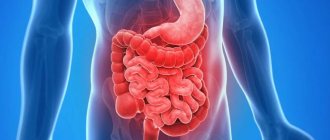Causes of abdominal pain in children
Abdominal pain, indigestion, constipation .
These problems are familiar not only to adults, but also to children. And while adults tend to ache with their stomachs after mistakes in their diet, in children discomfort is often caused by new foods that the baby’s body is not yet accustomed to. After adding new products to the diet, in addition to mother's milk and infant formula, babies often begin to cry, because they lack special enzymes produced, in particular, by the pancreas to digest unfamiliar food. This usually leads to stomach cramps and constipation.
Of course, the cause of colic is not so much the composition of the food, but the fact that the child swallows air while eating, which causes discomfort in the stomach, and this happens because the baby has not yet learned to eat new food correctly. If colic occurs, it is enough to hold the baby upright so that the air from the stomach escapes when burping.
First aid
Before visiting a doctor, if abdominal pain occurs, the child needs some help. You can’t stuff him with strange drugs, because you still don’t know what exactly needs to be treated. But it is quite possible to relieve symptoms without visiting a clinic. Below are step-by-step instructions, following which will not only relieve pain, but also prevent unwanted consequences.
Table. How to relieve abdominal pain in a child.
| Steps, photo | Description of actions |
| Step one | Often, abdominal pain is accompanied by other unpleasant symptoms. This may include fever, nausea, vomiting or constipation. Talk to your child before the doctor arrives. You can also call the clinic for advice. If the child cannot yet speak and talk about how he is feeling, then determine the symptoms yourself by measuring his temperature and examining him. |
| Step two | Give your child a tablet for stomach pain. Of course, you need to know which drug can help in this case, because the wrong drug can be harmful to your health. For example, if pain occurs in the upper abdomen, you need to give your baby Panzistal or Mezim. If the lower abdomen hurts, then Riabal or Mebeverine. You need to be careful here, because even if you give your child a regular painkiller, it may worsen his condition. |
| Step three | After your baby takes the pill, ask him to lie down on the bed. Sometimes even the most severe symptoms can be overcome by good sleep and rest. In any case, the child needs to relax and take a break from painful sensations, so if there is even the slightest chance to relax, take it. |
| Step four | Replenish the acidity level in your child's stomach by giving him plain water to drink. The fact is that when consuming certain foods, the acidity in the stomach can be disturbed, and drinking plenty of fluids can normalize it. If plain water does not help, buy a special medicine at the pharmacy that neutralizes the acid in the stomach. The most common of them include Rennie, Maalox, and Gevixon. |
| Step five | It is possible to alleviate the baby’s condition without the help of medications. Mint, ginger or papaya are used for this purpose. Just give your child one of these products in any form. This could be a fresh fruit or plant, mint or ginger tea, or special lollipops that contain papaya. All this can be easily found in any store in the city. 20-30 minutes after the child eats this, the painful sensations will subside. |
| Step six | Apply a hot compress to your baby's tummy. To do this, you need to heat a small towel or scarf in the oven or microwave and then apply it to the sore spot for 10-15 minutes. Under the influence of heat, the pain should subside, and the child will feel much better. If necessary, the procedure can be repeated. |
| Step seven | Once symptoms subside, feed your child chicken broth or other types of soup. It is very important to give liquid food that will not burden the gastrointestinal tract. You should avoid fatty foods or dairy products for now, as this can cause more severe pain. The same applies to carbonated drinks, large quantities of sweets, crackers or chips. Even in a healthy state, they are harmful to the baby’s health, not to mention abdominal pain. |
On a note! Try to somehow distract the child from his problem. To do this, read a book, watch an interesting movie or cartoon together, do something that can divert your child’s attention from painful sensations at least for a short time. To prevent the condition from worsening, do not allow him to lie on his stomach.
Constipation in children
As for constipation, in fact, this is only the name for constant rare bowel movements (1-2 times a week) in a child and the accompanying passage of gas or bloating, which can be a manifestation of diseases of the liver, pancreas or thyroid gland, therefore in In such a situation, you should consult a doctor.
If this is an isolated case associated with unusual food, then dried fruits (dried apricots, prunes and raisins) or fresh vegetables can help, since plant fiber helps to increase intestinal motility. A balanced diet and moderate exercise are usually sufficient to prevent constipation.
Pathologies that cause pain
Among all the diseases that can cause pain, it is worth highlighting the following:
- irritable bowel syndrome or IBS;
- chronic cholecystitis or inflammation of the gallbladder. This disease is accompanied by pain in the right side of the baby’s abdomen;
- pancreatitis, accompanied by dullness in the abdomen. As the pathology progresses, the pain may gradually intensify;
- inflammation of the gastric mucosa;
- pylorospasm;
- duodenal ulcer.
Child crying due to stomach pain
There are many factors that can cause abdominal pain, so this condition cannot be ignored. If abdominal pain continues to torment the child, then he should be shown to the pediatrician. After examining the patient, he will prescribe appropriate treatment or refer the baby to other doctors for examination - for example, to a gastroenterologist.
How to help your baby cope with new food?
How can you help your baby cope with new food? It’s very simple: after eating, give the child a drug that will contain those substances that are not enough for the intestines to function. One of these drugs is Creon. It contains pancreatic enzymes that aid digestion.
The use of enzyme preparations allows for complete absorption of all proteins, fats and carbohydrates that a child needs every day for growth and development. You can learn more about enzyme preparations from a pediatric gastroenterologist.
The transition from home-cooked food to food in a nursery or kindergarten also often causes intestinal upset and discomfort or even pain in the abdomen. Taking medications that improve digestion during the adaptation period is almost always quite effective. If medications like Creon do not help, then most likely the child has developed dysbiosis.
Causes of pain
The main factor causing abdominal pain may be the food itself. Often, eating any food leads to irritation of the esophageal mucosa. This is typical for very hot or cold food. We also must not forget that excessive consumption of fatty foods contributes to the appearance of gallstones that form in the baby’s bile ducts, which can ultimately lead to the development of bile disease.
On a note! It is necessary to take into account the fact that a person may have intolerance to certain foods, and it is quite difficult to identify this in children. Therefore, when consuming these products, pain occurs, which may also be accompanied by bloating.
The development of a stomach ulcer can also cause pain in the abdomen. In this case, the pain does not appear immediately after eating, but after about 30-40 minutes. Doctors explain this phenomenon by an increase in the level of hydrochloric acid in the stomach. After some time, the food will end up in the duodenum, which will lead to a decrease in the level of acidity in the child’s stomach. The development of a stomach ulcer is accompanied by pain in the central part of the abdominal cavity, but sometimes it can be localized in the upper or left part.
A child's stomach may hurt due to the development of a stomach ulcer.
Depending on the nature and time of manifestation, abdominal pain may indicate the development of various pathologies. For example, with pancreatitis, the stomach begins to hurt 1-2 hours after eating, and peptic ulcer disease, as a rule, is accompanied by pain at night. Therefore, you need to carefully find out all the details from the baby, and this is not an easy task.
Canteen food is the cause of stomach pain in children
Regardless of whether a child attends a child care facility or not, the cause of abdominal pain can be fatty, spicy foods or fast food (often, alas, from the parent’s table). These products have a negative effect on the functioning of the liver, gallbladder and pancreas. Most often, such problems arise in a child in elementary school, when he has the opportunity to independently diversify his diet. While educational work is going on and your child’s habit of healthy food is still inferior to the natural childhood passion for everything tasty and harmful, try not to overfeed your child at home. In second place after educational methods, there is also the use of drugs that improve digestion - “Creon” and the like.
Remember! Not a single child has ever starved himself to death or been hospitalized because he did not want to finish his porridge. The amount of food that parents and grandparents manage to cram into the unfortunate heir is not proof of love for their offspring and should not become a criterion of pedagogical success.
A child’s stomach hurts after eating - the main reasons and what to do about it
The appearance of abdominal pain after eating is a problem that not only adults, but also children can face.
But unlike adults, whose immune system is fully formed, the child’s body is not yet able to resist many pathologies, so the child’s stomach hurts much more often after eating.
This article will discuss the causes and methods of eliminating abdominal pain in children.
The child has a stomach ache after eating
Causes of pain
The main factor causing abdominal pain may be the food itself. Often, eating any food leads to irritation of the esophageal mucosa.
This is typical for very hot or cold food.
We also must not forget that excessive consumption of fatty foods contributes to the appearance of gallstones that form in the baby’s bile ducts, which can ultimately lead to the development of bile disease.
Cholelithiasis
On a note! It is necessary to take into account the fact that a person may have intolerance to certain foods, and it is quite difficult to identify this in children. Therefore, when consuming these products, pain occurs, which may also be accompanied by bloating.
The development of a stomach ulcer can also cause pain in the abdomen. In this case, the pain does not appear immediately after eating, but after about 30-40 minutes. Doctors explain this phenomenon by an increase in the level of hydrochloric acid in the stomach.
After some time, the food will end up in the duodenum, which will lead to a decrease in the level of acidity in the child’s stomach.
The development of a stomach ulcer is accompanied by pain in the central part of the abdominal cavity, but sometimes it can be localized in the upper or left part.
A child's stomach may hurt due to the development of a stomach ulcer.
Depending on the nature and time of manifestation, abdominal pain may indicate the development of various pathologies. For example, with pancreatitis, the stomach begins to hurt 1-2 hours after eating, and peptic ulcer disease, as a rule, is accompanied by pain at night. Therefore, you need to carefully find out all the details from the baby, and this is not an easy task.
Pathologies that cause pain
Among all the diseases that can cause pain, it is worth highlighting the following:
- irritable bowel syndrome or IBS;
- chronic cholecystitis or inflammation of the gallbladder. This disease is accompanied by pain in the right side of the baby’s abdomen;
- pancreatitis, accompanied by dullness in the abdomen. As the pathology progresses, the pain may gradually intensify;
- inflammation of the gastric mucosa;
- pylorospasm;
- duodenal ulcer.
Child crying due to stomach pain
There are many factors that can cause abdominal pain, so this condition cannot be ignored. If abdominal pain continues to torment the child, then he should be shown to the pediatrician. After examining the patient, he will prescribe appropriate treatment or refer the baby to other doctors for examination - for example, to a gastroenterologist.
What to pay attention to
As a rule, parents determine the appearance of painful sensations in a child’s abdomen quite quickly and easily . In this case, the baby is often capricious, cries and curls up into a ball. This applies to young children who cannot yet speak. With older children everything is much simpler - they themselves can describe their condition and the nature of the pain.
Child's stomach hurts
Parents need to pay sufficient attention to the following factors:
- duration of pain . If the pain goes away on its own after a few hours or days, this most likely indicates simple bloating. This condition does not threaten the child’s health;
- place of pain . If pain appears in the central part of the child’s abdominal cavity, then there is no need to panic. But with severe pain that affects other areas of the abdomen, parents should be wary. Acute appendicitis occurs with similar symptoms;
- the baby's condition and appearance . First of all, you need to worry if the baby’s skin turns pale, excessive sweating or general weakness of the body. Moreover, the child cannot be distracted by anything due to his condition. No games, conversations or even food can distract him; The child is capricious
- attacks of nausea and vomiting . Quite often, this symptom occurs in addition to attacks of abdominal pain. If vomiting does not go away for more than 24 hours, then you need to call a doctor;
- diarrhea _ If, in addition to pain in the abdomen, the child has diarrhea, this most likely indicates the development of viral inflammation. You can sound the alarm if blood appears in the stool;
- painful urination . If your baby experiences abdominal pain not only after eating, but also when urinating, this may indicate the development of pyelonephritis or an infectious disease.
Painful urination in a child
On a note! Many parents panic if their child has a fever. But it is worth noting that a high temperature with painful sensations in the abdomen does not always mean that the baby has a serious illness.
High temperature in a child
First aid
Before visiting a doctor, if abdominal pain occurs, the child needs some help. You can’t stuff him with strange drugs, because you still don’t know what exactly needs to be treated. But it is quite possible to relieve symptoms without visiting a clinic. Below are step-by-step instructions, following which will not only relieve pain, but also prevent unwanted consequences.
Table. How to relieve abdominal pain in a child.
Steps, photo Description of actions
| Step one | Often, abdominal pain is accompanied by other unpleasant symptoms. This may include fever, nausea, vomiting or constipation. Talk to your child before the doctor arrives. You can also call the clinic for advice. If the child cannot yet speak and talk about how he is feeling, then determine the symptoms yourself by measuring his temperature and examining him. |
| Step two | Give your child a tablet for stomach pain. Of course, you need to know which drug can help in this case, because the wrong drug can be harmful to your health. For example, if pain occurs in the upper abdomen, you need to give your baby Panzistal or Mezim. If the lower abdomen hurts, then Riabal or Mebeverine. You need to be careful here, because even if you give your child a regular painkiller, it may worsen his condition. |
| Step three | After your baby takes the pill, ask him to lie down on the bed. Sometimes even the most severe symptoms can be overcome by good sleep and rest. In any case, the child needs to relax and take a break from painful sensations, so if there is even the slightest chance to relax, take it. |
| Step four | Replenish the acidity level in your child's stomach by giving him plain water to drink. The fact is that when consuming certain foods, the acidity in the stomach can be disturbed, and drinking plenty of fluids can normalize it. If plain water does not help, buy a special medicine at the pharmacy that neutralizes the acid in the stomach. The most common of them include Rennie, Maalox, and Gevixon. |
| Step five | It is possible to alleviate the baby’s condition without the help of medications. Mint, ginger or papaya are used for this purpose. Just give your child one of these products in any form. This could be a fresh fruit or plant, mint or ginger tea, or special lollipops that contain papaya. All this can be easily found in any store in the city. 20-30 minutes after the child eats this, the painful sensations will subside. |
| Step six | Apply a hot compress to your baby's tummy. To do this, you need to heat a small towel or scarf in the oven or microwave and then apply it to the sore spot for 10-15 minutes. Under the influence of heat, the pain should subside, and the child will feel much better. If necessary, the procedure can be repeated. |
| Step seven | Once symptoms subside, feed your child chicken broth or other types of soup. It is very important to give liquid food that will not burden the gastrointestinal tract. You should avoid fatty foods or dairy products for now, as this can cause more severe pain. The same applies to carbonated drinks, large quantities of sweets, crackers or chips. Even in a healthy state, they are harmful to the baby’s health, not to mention abdominal pain. |
On a note! Try to somehow distract the child from his problem. To do this, read a book, watch an interesting movie or cartoon together, do something that can divert your child’s attention from painful sensations at least for a short time. To prevent the condition from worsening, do not allow him to lie on his stomach.
When to see a doctor
In rare cases, it is impossible to do without the help of a doctor, since subsequent ignoring of the symptoms can lead to serious consequences. Be sure to call your doctor if you notice any of the following symptoms:
- a rash appeared on the baby’s body;
- urination is accompanied by painful sensations;
- the child has bouts of vomiting, and the secreted mass is colored black or yellow;
- the appearance of blood in the stool;
- the pain that has been tormenting the child for more than a day has spread to other parts of the abdomen.
Child at the doctor
If any of the above symptoms appear, the child urgently needs to be taken to a medical facility, where the doctor will conduct the necessary tests to make a diagnosis. Self-medication in this case is not recommended.
Self-medication in this case is prohibited
Prevention
It is much easier to avoid abdominal pain in a child than to treat it later. Of course, it is impossible to avoid all digestive disorders, but there are methods to prevent many problems with the gastrointestinal tract .
First of all, you need to control the baby’s diet, limiting the amount of fried, fatty and starchy foods. Provide your child with enough fluids and teach him to wash his hands every time before eating. Depending on the age of the child, the daily fluid intake may vary.
Moreover, this applies only to pure water, and not to various drinks.
Monitor your child's diet
Under no circumstances should you give your child generic medications at the first complaint of abdominal pain. You don’t yet know exactly the cause of the pain, so taking the wrong medication may make the situation worse.
If pain occurs quite often, you should definitely consult a doctor for help, because this may not indicate banal flatulence or heartburn, but the development of more serious pathologies. Remember that there is nothing more important than children's health, so take the problem seriously .
Also, as a preventive measure, you need to periodically feed the child with foods that accelerate metabolic processes in the body. They must contain fiber, which helps cleanse the body of toxins and waste.
— Main causes of abdominal pain in children
Source: https://med-explorer.ru/gastroenterologiya/simptomatika/u-rebenka-posle-edy-bolit-zhivot.html
What to do if a child has overeaten?
To alleviate the child’s condition after overeating, it is necessary to provide him with peace. In this case, Creon can help due to the following feature: unlike other enzyme products, it consists of a capsule filled with mini-microspheres. The capsule opens in the stomach and minimicrospheres - this is a special, innovative dosage form - are quickly mixed with food.
Due to the fact that there are many minimicrospheres, they have better contact with food than other preparations that consist of one “large” sphere or tablet. Of course, enzymes need to be dosed depending on age and body weight, so you can open the capsule and count out as many “balls” as the doctor prescribed, and then easily close it. Thus, the acid-resistant coating is not broken, which happens to the tablet if it is divided into parts, which means that Creon will begin to act exactly where it is needed.
Prevention
It is much easier to avoid abdominal pain in a child than to treat it later. Of course, it is impossible to avoid all digestive disorders, but there are methods to prevent many problems with the gastrointestinal tract . First of all, you need to control the baby’s diet, limiting the amount of fried, fatty and starchy foods. Provide your child with enough fluids and teach him to wash his hands every time before eating. Depending on the age of the child, the daily fluid intake may vary. Moreover, this applies only to pure water, and not to various drinks.
Monitor your child's diet
Under no circumstances should you give your child generic medications at the first complaint of abdominal pain. You don’t yet know exactly the cause of the pain, so taking the wrong medication may make the situation worse. If pain occurs quite often, you should definitely consult a doctor for help, because this may not indicate banal flatulence or heartburn, but the development of more serious pathologies. Remember that there is nothing more important than children's health, so take the problem seriously . Also, as a preventive measure, you need to periodically feed the child with foods that accelerate metabolic processes in the body. They must contain fiber, which helps cleanse the body of toxins and waste.
Main reasons
Colic
The vast majority of children experience colic in the first two to three months of life. Scientists have not yet figured out the exact causes of colic, but one of the most common versions is that the cause is air that the baby accidentally swallows during feeding or when crying. The air compresses the walls of the fragile stomach, thereby causing severe pain. Also, in some cases, the cause may be improper preparation of the mixture or diet.
To identify colic in a child, you need to carefully observe his behavior: he will be very restless and agitated, and may also begin to cry out during and after meals.
The main symptoms of colic:
- inexplicable concern
- pallor,
- cry,
- the child presses his legs to his stomach, which indicates sharp pain in the stomach.
What to pay attention to
As a rule, parents determine the appearance of painful sensations in a child’s abdomen quite quickly and easily . In this case, the baby is often capricious, cries and curls up into a ball. This applies to young children who cannot yet speak. With older children everything is much simpler - they themselves can describe their condition and the nature of the pain.
Child's stomach hurts
Parents need to pay sufficient attention to the following factors:
- duration of pain . If the pain goes away on its own after a few hours or days, this most likely indicates simple bloating. This condition does not threaten the child’s health;
- place of pain . If pain appears in the central part of the child’s abdominal cavity, then there is no need to panic. But with severe pain that affects other areas of the abdomen, parents should be wary. Acute appendicitis occurs with similar symptoms;
- the baby's condition and appearance. First of all, you need to worry if the baby’s skin turns pale, excessive sweating or general weakness of the body. Moreover, the child cannot be distracted by anything due to his condition. No games, conversations or even food can distract him;
The child is naughty
- attacks of nausea and vomiting . Quite often, this symptom occurs in addition to attacks of abdominal pain. If vomiting does not go away for more than 24 hours, then you need to call a doctor;
- diarrhea _ If, in addition to pain in the abdomen, the child has diarrhea, this most likely indicates the development of viral inflammation. You can sound the alarm if blood appears in the stool;
- painful urination . If your baby experiences abdominal pain not only after eating, but also when urinating, this may indicate the development of pyelonephritis or an infectious disease.
Painful urination in a child
On a note! Many parents panic if their child has a fever. But it is worth noting that a high temperature with painful sensations in the abdomen does not always mean that the baby has a serious illness.
High temperature in a child
A child has a stomach ache: in what cases should you urgently find a doctor?
- 1 The child has a stomach ache, but the pain is not in the navel area;
- 2 Pain lasts more than 24 hours;
- 3 If abdominal pain is accompanied by one or more of the following symptoms:
- the child broke out in a cold sweat and his skin became pale;
- the child's temperature has risen sharply;
- there is blood in the stool or vomit (any amount - even one drop is enough to “fly” to the doctor!);
- a rash appeared on the child’s body;
- it became painful for the baby to pee (painful urination);
- the child vomits and the vomit is yellow, green, or black;
- The baby has become very lethargic, sleepy, and refuses not only to eat, but also to drink.
- in boys - abdominal pain is combined with pain in the groin or testicles.
4 If a child has a stomach ache, but the pain is not constant, but episodic, and at the same time it is combined with diarrhea, which has lasted for more than 72 hours, or is combined with vomiting, which has not gone away for more than a day.
The vast majority of cases of abdominal pain in a child that are not included in this list (that is, the pain is localized in the navel area and is not accompanied by the above symptoms) do not require medical intervention.
And yet, no one has canceled the pain! The child really suffers from having a stomach ache. How can you help him in such cases (since you have determined that he does not need emergency medical care)?











